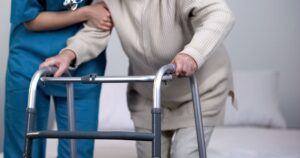Parkinson’s is a neurodegenerative disorder that affects everyone differently; symptoms generally develop slowly over years, manifesting themselves differently from one person to the next. No two people experience Parkinson’s the same way so expectations will vary, but there are many commonalities that people with the disease share.
What are the Early Symptoms of Parkinson’s?
It is important to pay attention to the early signs and symptoms of Parkinson’s. Following are the ten most common signs of Parkinson’s disease (PD). It’s important to note that many of these symptoms can be caused by other common health issues. No single symptom should be cause for concern, but if you or a loved one are experiencing many of these symptoms it is best to consult a medical professional.
- Tremors: A slight shaking in the fingers, hand or chin – especially when a person isn’t moving – is one of the most common, early signs of the condition.
- Handwriting Changes: If handwriting starts to change – especially if it’s getting smaller, the letters are shrinking, and the words are crowded together – it could be a sign of Parkinson’s called micrographia.
- Loss of Smell: If someone can no longer smell certain foods well – bananas, dill pickles, licorice – it could be an early sign of PD. Of course, this could simply be the result of a stuffed-up nose, cold or flu as well.
- Trouble Sleeping: Insomnia is often a result of many other emotional and physical issues but may indicate Parkinson’s, especially if troubled sleep involves thrashing around or sudden movements in the middle of the night that didn’t previously occur.
- Trouble Moving or Walking: Body stiffness and discomfort or mobility issues could be the result of over-exercising, being out of shape or arthritis. But if the stiffness and limb rigidity persist and don’t go away after moving or walking, if someone’s arms aren’t swinging the way they used to when they walk, or if they have lost their usual stride and are shuffling, it may be a sign of Parkinson’s. People sometimes say their feet seem “stuck to the floor”. The slowness of movements (bradykinesia) is a related symptom.
- Stooping or Hunching Over: While this could also indicate osteoporosis or be the result of an injury or some other skeletal issue, when someone isn’t standing up as straight as they used to and is slouching or walking hunched over, it is often one of the early signs of Parkinson’s.
- Dizziness or Fainting: In addition to an altered gait and stature, balance problems and feeling dizzy or faint can also be early indicators of Parkinson’s. Low blood pressure, which can cause this dizzy feeling, is often linked to PD.
- Changes in Voice: A soft or low voice, and/or sounding hoarse all the time may also be an early indicator of Parkinson’s.
- Masked Face: Another early sign of Parkinson’s is called a “masked face” or “facial masking”. This could take the form of a blank stare, a seemingly immobile and serious expression or angry look. If someone is staring off into space and seemingly expressionless, it should be noted.
- Constipation: This can also be an early sign of Parkinson’s disease but may also be a result of dehydration, lack of fibre in the diet and/or certain medications.
Again, one of these symptoms alone is not enough to prompt concern about Parkinson’s but put them together, it warrants a visit to the doctor.
Understanding the Five Stages of Parkinson’s
In Stage One, a person’s symptoms are mild and do not interfere dramatically with daily activities. Tremor and movement symptoms tend to occur on just one side of the body. Changes in posture, walking and facial expressions will begin to be noticed.
In Stage Two, symptoms start to progress. Tremor, rigidity and other movement issues will now affect both sides of the body. Walking problems and poor posture are more apparent. A person is still able to live alone without in-home care, but daily tasks are more difficult and take longer to accomplish.
Stage Three is considered the “mid-stage” of the condition, with loss of balance and slowness of movements being the hallmarks. Falls are more common, and while a person can still live a fully independent life, symptoms begin to impair the ability to accomplish daily activities with ease, such as getting dressed. Home care assistance should be considered in these instances, which can be accessed through numerous aged care providers.
In Stage Four, symptoms become more severe and limiting. A person may still be able to stand without assistance, but movement may require a walker. Most likely, a person will need help from a nurse at home with most activities associated with daily living and should not be living alone.
Stage Five of the disease is the most advanced and debilitating stage. Symptoms become more severe and limiting. Stiffness in the legs may make it impossible to stand or walk; one may be confined to a wheelchair, and in the end, totally bedridden. A person living alone will require 24-hour in-home nursing care at this stage, as they will not be able to feed or bath themselves. At this stage, a person may also experience hallucinations and delusions.
How to Treat Parkinson’s Disease
The good news is that while there is no “cure”, Parkinson’s is a highly treatable condition, especially in the early stages. With proper diagnosis and treatment, many Parkinson’s patients continue to lead productive, self-sufficient lives for many years.
There is no standard treatment for Parkinson’s disease; treatment for each person is based on his or her symptoms. Treatments include medication, physical therapy and lifestyle modifications such as dietary changes. Dietary and nutritional changes can have a huge impact on health and comfort, as can getting more rest, better sleep, fresh air and appropriate levels of exercise.
Emotional well-being is as important as physical wellness. People with Parkinson’s should enlist support from family, friends and colleagues and stay active and engaged to the extent it is possible. Aged care service providers are also an invaluable resource.
Though none of the many Parkinson’s medications can reverse the effects of the disease, they can effectively mitigate and manage the symptoms for long periods of time in some instances. Discovering the right medications, complementary therapies, professional aged care services and personal support, as well as ways to stay independent, can enhance the quality of life for Parkinson’s patients. Trying something like music therapy can be a great way to help those with Parkinson’s build strength while doing something they enjoy.
There are many ways to maintain a good quality of life when living with Parkinson’s. There is most likely a Parkinson’s Foundation or other aged care agencies in your area which can provide support and important resources, including networking groups, in-home care services, and guidance on how to forge a path forward if someone lives alone without a primary Carer.
As a leading age care provider, Home Care Assistance offers tailored in-home care services for older Australians, enabling them to live happier and healthier lives in the comfort of their own homes.
We offer private and government subsidised Care Packages and have office locations that are a registered NDIS provider. Our Care Workers undergo extensive training in order to deliver unmatched in-home aged care services where people can continue ageing in place. We are proud ambassadors of the My Aged Care government funded aged care program, enabling Australians to successfully navigate the process and gain approval for in-home care support packages. Home Care Assistance offers hourly care, specialised care, Alzheimer’s and Dementia care, hospital to home care, and 24 hour in home care.













